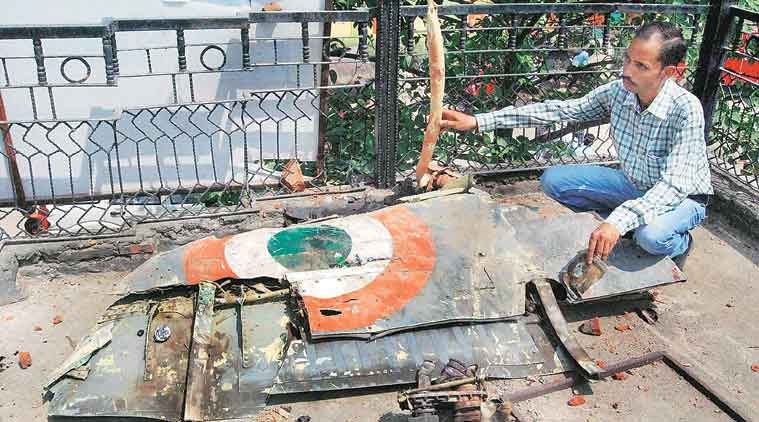Jaguar crash: And one more goes down. The math behind IAF’s fighters
While the exact number of combat squadrons can be a matter of debate, what is beyond dispute is that every single loss counts. The sooner it is stopped, the better.
 The wreckage of the Jaguar that crashed at Chaka village near Allahabad.(source: PTI)
The wreckage of the Jaguar that crashed at Chaka village near Allahabad.(source: PTI)
The two-seater Jaguar that crashed near Allahabad on Tuesday was the sixth Indian Air Force (IAF) fighter to crash this year, weakening the combat potential of the IAF. Weeks ago, Defence Minister Manohar Parrikar had said India’s decision to acquire 36 Rafale fighters from France was meant to meet IAF’s “urgent requirement”.
So how many squadrons (each of 18 fighters) does the IAF need? A more precise answer will emerge from the task assigned to the IAF by the government, something that is spelled out in the ‘Raksha Mantri’s Directive’, a document that guides the country’s military roadmap. The directive calls for the armed forces to be prepared to fight a two-front war: against Pakistan and China.
[related-post]
This translates into IAF maintaining a dominant superiority over the Pakistan Air Force (PAF) and adequate dissuasive power against China’s People’s Liberation Army Air Force (PLAAF). Against PAF, the superiority has to be both qualitative and quantitative, while against PLAAF, IAF will have to display its technical and operational edge.
In 1959, IAF had estimated that 64 squadrons, including 45 combat squadrons, were required to fulfill that role. This was quite an increase from what IAF possessed on January 26, 1950: six fighter squadrons of Spitfires, Vampires and Tempests, and one B-24 bomber squadron.
 Even though the defeat in the 1962 war corroborated this requirement of 45 squadrons, it was beyond India’s means to buy so many aircraft. This led to a Government Authorised Establishment (GAE) of 39.5 fighter squadrons. IAF attained the goal of 39.5 squadrons by the mid-1980s: the numbers have only declined since then. In 2011, IAF resubmitted its case for a GAE of 45 fighter squadrons to counter a collusive two-front threat — Pakistan and China fighting together — but the government sanctioned only 42 combat squadrons. They were supposed to be in place by 2022.
Even though the defeat in the 1962 war corroborated this requirement of 45 squadrons, it was beyond India’s means to buy so many aircraft. This led to a Government Authorised Establishment (GAE) of 39.5 fighter squadrons. IAF attained the goal of 39.5 squadrons by the mid-1980s: the numbers have only declined since then. In 2011, IAF resubmitted its case for a GAE of 45 fighter squadrons to counter a collusive two-front threat — Pakistan and China fighting together — but the government sanctioned only 42 combat squadrons. They were supposed to be in place by 2022.
The IAF currently has 35 fighter squadrons — 32 are available if you keep out those in maintenance and under upgrade. But the rate at which vintage fighters are retiring exceeds the rate at which their newer replacements are being inducted. If all acquisitions happen as per plan, IAF will have 42 squadrons by 2027.
But that is a big ‘if’. The 272 Su-30 MKI fighter aircraft contracted by IAF will be delivered by 2030. HAL’s supply of the LCA and the development of the Fifth Generation fighter with Russia are behind schedule.
But what is sacrosanct about this number of 42 (or 45) fighter squadrons? Even the defence minister has stated that India can do with 37-38 active squadrons. The figure of 45 that was arrived at decades ago when fighter aircraft had far lesser capability should not hold true now. Moreover, India now possesses nuclear weapons and strategic delivery systems which have altered the way any future war will be joined. In a pre-nuclear era, the IAF was viewed as the nation’s premier quick reaction force in the event of a surprise attack. That scenario is now inconceivable.
The counter argument is the increased number of geographically dispersed targets given to the IAF, and adversary’s enhanced capacity. Pakistan has 21 active combat squadrons and is building up to 25. By 2022, IAF could also come down to the same number of squadrons. PAF is also acquiring beyond-visual-range air-to-air missiles for its aircraft. New PAF fighters are equipped with advanced airborne jamming pods and other defensive technologies.
Though the IAF will still have an advantage over PAF in the event of a conflict, without substantial numerical superiority, its flexibility will be highly constrained. Besides Pakistan, IAF has to also prepare for the PLAAF. By 2020, PLAAF will possess more fourth generation fighters than the total number of aircraft with the IAF. This will be in addition to the bombers, cruise missiles, UAVs, ballistic missiles, electronic warfare, computer network attack and counterspace elements held by the Chinese.
While the exact number of combat squadrons can be a matter of debate, what is beyond dispute is that every single loss counts. The sooner it is stopped, the better.
- 01
- 02
- 03
- 04
- 05






































